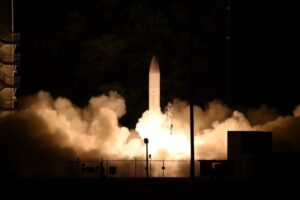The Navy’s FY ‘24 budget request revealed the service’s plans to procure 64 hypersonic weapon rounds for $3.6 billion over the next five years.
The Navy is starting with seeking $341 million to buy eight all-up rounds of what it called the Conventional Prompt Strike (CPS) weapon in FY ‘24, according to details of the Navy’s budget justification documents released recently.
The first eight will be followed by 10 more for $441 million in 2025, 11 for $663.4 million in 2026, 16 for $989 million in 2026 and 19 for $1.18 billion in fiscal year 2028. That makes for $3.6 billion for 64 weapons over the next five years.

The Navy is working with the Army to design and develop a common All Up Round (AUR) consisting of a Common Hypersonic Glide Body (C-HGB), a missile body with a 34.5 inch two-stage booster and a thermal protection system.
The Navy is specifically responsible for designing the C-HGB while the Army is in charge of unit production. The Navy will also “design, develop, and produce the missile booster, as well as integrate the missile booster with the C-HGB,” budget documents confirmed.
Each service plans to use the C-HGB while they develop their own launchers and weapon control systems to best deploy the weapons from the sea or land.
Last month, two naval researchers explained that while hypersonic weapons have an advantage in speed and survivability to reach a target, they are very expensive due to the difficult mechanical and physical problems to operate them. This includes requiring communications and sensors that can withstand a plasma sheath that develops after Mach Five speeds, expensive exotic materials needed to withstand high temperatures and speeds, dissipating that heat, and maintaining the engine process efficiently (Defense Daily, March 7).
“I’m not too sure hypersonics is a radical game changer because they’re going to be hard to produce and afford in quantity. Maybe that’s okay, if you’re just going to use them for the exquisite targets and that’s kind of it,” David Kiel, director of the Directed Energy Warfare Office at the Office of Naval Research, said during the West 2023 conference.
The Navy plans to start deploying CPS on the Zumwalt-class destroyers in fiscal year 2025 by replacing the unused Advanced Gun System on each of the three ships in the class with four new CPS-capable 87-inch large diameter missile tubes and CPS weapons. The work will occur during an 18-month long availability starting in FY ‘24.
This will be followed by integrating CPS on Virginia-class submarines with the Virginia Payload Module starting in FY ‘29.
Last November, Vice Adm. Johnny Wolfe, the Navy’s director for Strategic Systems Programs, said the main challenge of integrating CPS on the Zumwalt-class ships is finishing the work in time with a tight schedule (Defense Daily, Nov. 8, 2022).
Budget documents noted procurement lead time for the AURs and accompanying canisters is about 32 months from contract award.
Lockheed Martin [LMT] is the contractor producing the first set of Navy hypersonic missiles and the service expects the government to award production in October with delivery first starting in June 2026 at a cost of $38.5 million.
In January, the Navy awarded HII’s Ingalls Shipbuilding [HII] a contract to start planning the modernization work needed to later integrate the CPS system into the Zumwalt-class. The work will eventually occur at the Ingalls facility in Pascagoula, Miss.
While General Dynamics’ Bath Iron Works (BIW) [GD] built the three destroyers, HII made the deckhouses.
The Navy plans to conduct two to three CPS test shots from DDG-1000 before the end of 2025.
The budget details came after the Army and Navy had to cancel a planned March 5 hypersonic test due to a battery not activating as planned (Defense Daily, March 10).
When asked why the Navy is still buying the first eight CPS rounds despite it not being been fully tested, especially in light of the March test cancellation, Navy officials said the budget plans show they still have confidence in the capability.
“I think what you’re seeing here is a — is an endorsement of the capability, again, very central to matching the pacing challenges in the Asia-Pacific,” Deputy Assistant Secretary of the Navy for Budget Rear Adm. John Gumbleton said on March 13 during the initial budget rollout press conference.
“The point of testing is to learn things. But we have confidence that we’re going to be able to field the system as required and we’ll work with our industrial partners to make sure we stay on track for that — for that production,” he added.